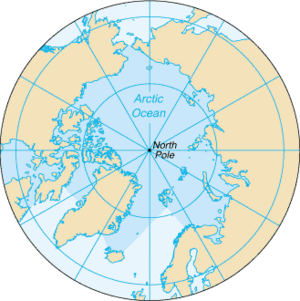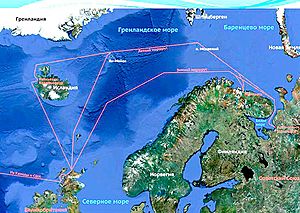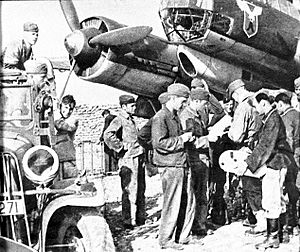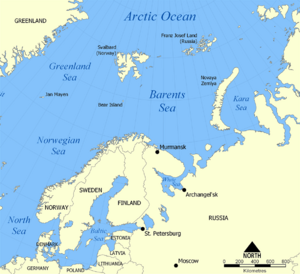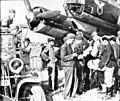Convoy QP 14 facts for kids
Quick facts for kids Convoy QP 14 |
|||||
|---|---|---|---|---|---|
| Part of The Arctic convoys of the Second World War | |||||
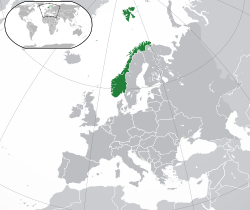 German occupied Norway (in green) lay along the flank of the sea route to northern Russia |
|||||
|
|||||
| Belligerents | |||||
| Commanders and leaders | |||||
| Karl Dönitz | John Dowding | ||||
| Strength | |||||
| 7 U-boats | 17 merchant ships 65 escorts |
||||
| Casualties and losses | |||||
| 1 U-boat sunk 5 damaged |
3 merchant ships sunk 2 warships sunk |
||||
Convoy QP 14 was a group of ships that traveled together for safety during World War II. This convoy, which sailed from 13 to 26 September 1942, was part of the Arctic convoys. These convoys carried important supplies from Allied countries to the Soviet Union and back.
Convoy QP 14 was a return journey. It brought Allied ships from the port of Archangelsk in the Soviet Union back to Loch Ewe in Scotland. The British planned this journey carefully. They sent another convoy, Convoy PQ 18, from Iceland to Murmansk. When the two convoys met, many of the warships protecting PQ 18 would switch to QP 14 to help it through the most dangerous waters near Norway.
Instead of just having a few large warships far away, the British created a strong "Fighting Destroyer Escort." This group of destroyers was meant to protect Convoy PQ 18 and then QP 14. They could fight German ships on their own. To keep all these escort ships fueled, special fuel tankers were sent to Svalbard. More fuel ships joined Convoy PQ 18. On 16 September, many of the PQ 18 escort ships and fuel tankers moved to QP 14 as the convoys crossed paths.
On 19 September, there was a false alarm about German ships attacking. The convoy only faced attacks from German aircraft and submarines (U-boats). The German attacks sank three merchant ships and two escort warships. The Allies, in turn, sank one U-boat and damaged five others. The aircraft from the escort carrier HMS Avenger were very helpful in stopping U-boat attacks. Land-based aircraft also helped from 23 September onwards. Convoy QP 14 successfully reached Loch Ewe in Scotland on 26 September.
Rear-Admiral Robert Burnett, who commanded the escort operation (called Operation EV), thought it was a success. He knew the risks were high. He said that if bad weather had stopped refueling, or if the U-boats and German air force (Luftwaffe) had worked together better, it could have been another disaster like Convoy PQ 17.
Contents
Background to the Arctic Convoys
The Challenging Arctic Ocean
The waters between Greenland and Norway are some of the stormiest in the world. They are often hit by gales with snow, sleet, and hail. Near the North Cape and in the Barents Sea, the sea temperature is usually very cold, around 4° Celsius. If a person falls into the water, they need to be rescued immediately to survive. The freezing air and water cause ice to build up on ships, which must be removed quickly so the ship doesn't become too heavy and tip over.
Warm water from the Gulf Stream meets the cold Arctic water. This mix of warm and cold water often creates thick fog, which convoys could use to hide. However, these mixed waters also made it hard for Asdic (sonar) to detect U-boats. In winter, the polar ice can extend far south, forcing ships closer to German air bases. In summer, the ice melts back, allowing ships to sail further out to sea. The area has constant darkness in winter and constant daylight in summer, which affects how easy or hard it is for planes to see ships.
Why Arctic Convoys Were So Important
In October 1941, after Germany invaded the USSR (called Operation Barbarossa), British Prime Minister Winston Churchill promised to send convoys to the Soviet Union's Arctic ports every ten days. These convoys delivered huge amounts of military supplies, like tanks and aircraft, to help the Soviet war effort.
By late 1941, the convoy system used in the Atlantic was also used in the Arctic. A "convoy commodore," usually a retired naval officer, led the merchant ships. He made sure all ship captains knew the plan for sailing in formation. This helped the ships stay together and follow instructions from the escort commander.
After the terrible losses of Convoy PQ 17 in July 1942, Arctic convoys were paused for nine weeks. During this time, Admiral John Tovey decided that the main British fleet (Home Fleet) wasn't very helpful to convoys beyond Bear Island. He decided that future convoys needed stronger protection against German surface ships. Longer-range destroyers from the Home Fleet would join the close escort. This way, they could launch a powerful torpedo attack if German ships tried to attack.
The new escort carrier HMS Avenger was also added to the escort force. This ship could carry aircraft, providing air cover for the convoy, which was a big advantage.
Secret Intelligence: Code-breaking
Bletchley Park: British Code-breakers
The British had a secret code-breaking center called Bletchley Park. By June 1941, they could quickly read messages from German U-boats and surface ships that used the "Enigma" machine. Even when the Germans changed their Enigma codes for U-boats in other areas in February 1942, the U-boats in the Arctic still used the older codes, which the British could read.
British listening stations (called Y-stations) could also intercept and read German air force (Luftwaffe) radio messages. This gave them early warnings about Luftwaffe operations. From May 1942, special RAF teams were put on warships. They could interpret Luftwaffe radio signals, sometimes predicting attacks 20 minutes before radar detected them. This secret information, called "Ultra," was incredibly valuable.
German Code-breakers: B-Dienst
The Germans also had their own code-breaking service, called "B-Dienst." By 1939, they had broken several British naval codes. This helped German warships avoid British forces and plan surprise attacks. For example, from June to August 1940, six British submarines were sunk using information from British radio signals.
In February 1942, B-Dienst broke the British "convoy cipher." By March, they could read up to 80 percent of these messages. This continued until December 1943. This meant the Germans often knew where British convoys were going and what their plans were. In early September, Finnish intelligence also deciphered a Soviet message that revealed the convoy's route, which they shared with the Germans.
Preparing for Battle
German Air Force (Luftwaffe) Plans
In March 1942, Adolf Hitler ordered a stronger effort against Allied convoys. He wanted to weaken the Red Army and prevent Allied troops from being sent to northern Russia. The German air force in Norway (Luftflotte 5) was strengthened with more planes. The German navy (Kriegsmarine) was ordered to stop the Arctic convoys. The air force and navy were told to work together more closely.
Luftflotte 5 was divided into different commands. The largest, Fliegerführer Nord (Ost), was based at Kirkenes. Its planes attacked Murmansk and Archangelsk, and also convoys. Other units were based at places like Petsamo and Banak. Fliegerführer Nord (West) was responsible for finding convoys early and attacking them south of Trondheim.
Luftwaffe Attack Strategies
When a convoy was spotted, long-range reconnaissance planes would search for it. Once found, aircraft would try to stay in contact, even in bad weather. If contact was lost, they would guess the convoy's path and send out more planes to find it again. All three air commands would work together as the convoy moved through their areas.
The goal was to keep up a continuous attack until the convoy reached its destination. However, early efforts against convoys in March to May had limited success. Bad weather was often as dangerous as the Luftwaffe, forcing many ships to turn back. Air attacks rarely involved more than twelve aircraft, making it easier for convoy gunners to shoot them down.
After some failures, the Luftwaffe and Kriegsmarine improved their teamwork. By May 1942, Luftflotte 5 had grown to 264 front-line aircraft in northern Norway. These included many bombers, torpedo-bombers, and reconnaissance planes.
The "Golden Comb" Tactic
After studying their attacks on Convoy PQ 17, the Luftwaffe developed a new tactic called "Goldene Zange" (Golden Comb). They gathered 35 Junkers Ju 88 dive-bombers and 42 torpedo-bombers. The Ju 88 bombers would attack first to distract the convoy's defenses. Then, the torpedo-bombers would fly very low, just above the waves, to avoid radar. They would approach the convoy in a line, dropping their torpedoes all at once.
When German intelligence found out that an aircraft carrier (HMS Avenger) would be with the next convoy, Hermann Göring, the head of the Luftwaffe, ordered that it must be sunk first. German aircrews were told that destroying the convoy would greatly help the German army fighting in Stalingrad.
German Air-Sea Rescue
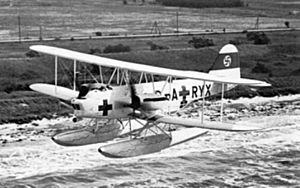
The German Luftwaffe Sea Rescue Service worked with the navy and other groups to rescue aircrews and shipwrecked sailors. This was very important in the cold Arctic climate, where quick rescue was vital for survival. However, there was a shortage of rescue aircraft and crews. The Luftwaffe high command ordered coastal reconnaissance squadrons, which usually didn't attack convoys, to be ready for rescue missions during anti-shipping operations.
The German navy's operations in the Arctic were commanded by Admiral Boehm. Large surface ships and U-boats were under a separate command, the Flag Officer Northern Waters. This officer also had tactical control over Luftwaffe aircraft when they supported the navy.
In August, the German cruiser Admiral Scheer carried out "Operation Wunderland," sailing north of Novaya Zemlya and sinking a Soviet icebreaker. German intelligence also learned about the meeting points for convoys PQ 18 and QP 14. Seven U-boats were positioned in the Norwegian Sea to attack PQ 18. The Kriegsmarine also planned "Operation Double Hit" (Unternehmen Doppelschlag), where the cruisers Admiral Scheer, Admiral Hipper, and Köln with four destroyers would attack the convoy. However, larger ships like Tirpitz were still being repaired and were not available.
British Preparations: Operation Orator
After the losses of Convoy PQ 17, the British sent replacement supplies to Archangelsk using destroyers. These ships arrived safely despite being spotted by German planes. In August, the Royal Air Force sent a special group of aircraft, called the Search & Strike Force (Operation Orator), to the USSR. This force included torpedo bombers and reconnaissance planes to guard against German ship attacks.
During the return journey of some American ships that delivered ground crews, British intelligence (Ultra) revealed the route of a German minelayer called Ulm. Three destroyers were sent to intercept it. Ulm was sunk that night, and 60 survivors were captured. This forced the Germans to use the heavy cruiser Admiral Hipper as a minelayer instead.
Operation EV: The Convoy's Journey
Operation EV was the plan to escort Convoy PQ 18 to the northern USSR and then have its escorts join the returning Convoy QP 14. PQ 18 had 40 merchant ships and several minesweepers. Convoy QP 14, the focus of this article, had 17 merchant ships and 65 escort ships.
The escort force for QP 14 included various types of ships:
- Close Escort: Led by HMS Bramble, this group included minesweepers, destroyers, anti-aircraft ships, corvettes, and anti-submarine trawlers.
- Carrier Force: The escort carrier HMS Avenger with its fighter and torpedo-bomber aircraft, plus two destroyers.
- Fighting Destroyer Escort (FDE): This was a large group of 16 destroyers, commanded by Rear-Admiral Robert Burnett in the cruiser HMS Scylla. Their job was to provide strong protection against German surface attacks and U-boats.
- Other Support: Fuel tankers (Force P) were sent to Svalbard to refuel the escorts. A Cruiser Covering Force and a Distant Covering Force (with battleships) were also nearby, ready to help if needed. Submarines were also positioned to guard against German ships.
The Voyage Begins: 13–15 September
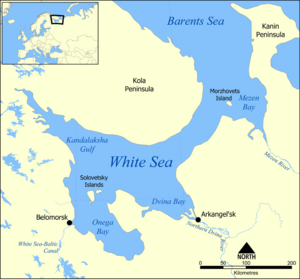
Convoy QP 14 left Archangelsk on 13 September, just as German attacks on Convoy PQ 18 were starting. The convoy was first escorted by four anti-submarine minesweepers, which left after two days. The main Close Escort then took over. The first few days were quiet, but on the night of 15/16 September, two merchant ships, Troubador and Winston Salem, fell behind the convoy.
Meeting at Sea: 16–17 September
The aircraft carrier Avenger had managed to get more of its Sea Hurricane fighter planes ready. On 16 September, Convoy QP 14 passed Convoy PQ 18. The escort ships began to transfer, with many of PQ 18's escorts joining QP 14. This transfer was completed by early morning on 17 September. The weather was very cold with low, snow-filled clouds. German planes were mostly focused on PQ 18, so only a few shadowing aircraft kept an eye on QP 14. As the weather worsened, these planes lost contact.
U-boat Sightings: 18 September
Shadowing aircraft reappeared on 18 September but again lost contact in bad weather. A British Catalina plane approached the convoy but gave the wrong signal, causing confusion. The Catalina crew reported seeing two U-boats on the surface ahead of the convoy. To stay away from German airfields, Admiral Burnett steered the convoy north towards Svalbard to meet a fuel tanker. Destroyers were sent ahead to meet the tanker. Later that evening, a Swordfish plane spotted a U-boat behind the convoy and attacked it with depth charges, but the result wasn't clear.
False Alarms and Real Threats: 19 September
In the morning, the destroyer Offa was sent to investigate what looked like German ships. It turned out to be Winston Salem, the merchant ship that had fallen behind. Offa escorted it back to the convoy. To trick German U-boats, several destroyers sailed across the convoy's path as it changed course.
Swordfish planes spotted several U-boats near the convoy, forcing them to dive. A German reconnaissance plane was also present. A distress call came from Troubador, the other straggling merchant ship, which was under U-boat attack. A Swordfish was sent to provide air cover, and the destroyer Onslaught raced to help. Onslaught dropped depth charges and used searchlights to keep the U-boats away while urging Troubador to speed up. That night, the ships headed to meet more fuel ships and their escorts.
Intense U-boat Attacks: 20 September
At 5:20 a.m., the minesweeper Leda, at the rear of the convoy, was hit by two torpedoes from U-453. The ship stayed afloat for an hour, and most of the crew were rescued, but six men died. As more U-boats gathered, Swordfish patrols spotted them on the surface. Around noon, five U-boats were stalking the convoy. A Swordfish attacked one U-boat with depth charges. The destroyer Ashanti also attacked a U-boat, seeing oil and bubbles, and claimed it was sunk.
Later, the merchant ship Silver Sword was torpedoed by U-255 and caught fire. Its crew was rescued, and the burning ship was sunk by the destroyer Worcester. The captain of Avenger reported that his Swordfish crews were exhausted. Admiral Burnett decided that Avenger and his flagship, Scylla, were too risky to keep with the convoy. He moved to another destroyer, and Avenger, Scylla, and some other destroyers left the convoy.
At 7:00 p.m., the destroyer Somali was torpedoed by U-703. Other destroyers rushed to help, taking off survivors. The captain of Somali asked for his ship to be towed, and Ashanti was ordered to help.
Continuing the Fight: 21 September
British radio detection (huff-duff) picked up signals from at least three U-boats near the convoy. Two German reconnaissance planes also arrived to shadow the ships. While ships were helping the damaged Somali behind the convoy, Admiral Burnett had to break radio silence to find their position.
Catalina flying boats from Shetland began to escort the convoy. One Catalina from a Norwegian squadron attacked U-378, which fired back and damaged the plane. Despite losing fuel, the Catalina crew continued their attack, dropping depth charges. The crew later landed and were rescued by the destroyer Marne, which then sank the Catalina. Later, the minesweeper Bramble and Worcester dropped depth charges, but the U-boat used a decoy to escape. The success of anti-submarine efforts was difficult due to changing sea temperatures affecting sonar, but five U-boats were damaged.
More Losses and the Final Stretch: 22 September
At 5:30 a.m., Admiral Burnett left the convoy, handing command to Alan Scott-Moncrieff. At 6:30 a.m., U-435 managed to get inside the escort screen and quickly sank three ships: Bellingham, Ocean Voice, and the fuel tanker Grey Ranger. Luckily, there were no casualties from these sunken ships. The convoy commodore, John Dowding, was rescued again. The escort screen was tightened, with destroyers patrolling the flanks. A final U-boat sighting occurred in the afternoon, but no more ships were lost.
Reaching Safety: 23–26 September
Regular Catalina patrols continued to appear, providing air cover. Some rescue ships and destroyers left to refuel. On 23 September, a Catalina from 210 Squadron spotted and sank U-253. The weather worsened, with a strong gale blowing. This made the merchant ships roll and pitch violently. Winston Salem had to stop and face the gale. Despite the risk, the destroyer Martin stayed to watch over it.
By 25 September, the gale calmed down, and the convoy continued in a heavy swell. The rescue ships and three destroyers rejoined the convoy. The next day, more escort ships left for their home bases. When the convoy reached Cape Wrath in Scotland, the remaining Home Fleet destroyers left, and the ships anchored safely at Loch Ewe. Winston Salem arrived later.
Images for kids
-
Example of a Heinkel He 59 search and rescue aircraft (1940)


